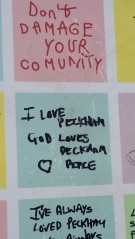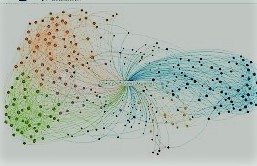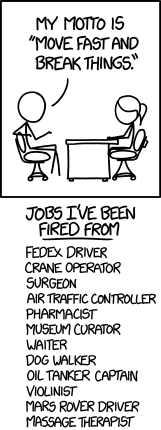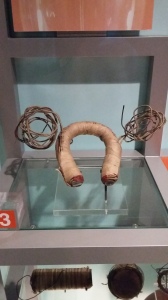
Peckham and godliness might not seem an obvious combination if what you’ve heard has mostly been about gangs, riot and murder. If you’ve travelled through here early on a Sunday you will know different. Katrin Maier quotes her own fieldnote, and it chimes with what I’ve seen:
It is about nine am on a Sunday morning and I am on the way to the Sunday Service at RCCG Tower of God. There is little traffic on the roads, but the bus from Peckham to Tower of God on the Old Kent Road is packed. Most passengers are well-dressed black men, woman and children, some holding Bibles. One passenger jokes that the Bus 78 that takes us to the churches on the Old Kent Road has become a ‘church bus’.
The picture above shows a mural not far from Peckham Rye, where William Blake said he had seen a vision of angels in an oak tree. Angelic Peckham Rye.

This area of London has plenty of other religious communities and buildings, but although I have no special expertise I’m going to focus here on its many types of Christianity, since what is most striking about how Peckham does God is the sheer number of newish and in traditional UK terms, non-traditional churches and chapels. I first started noticing their names years ago and meant to write about those, but now I’m less concerned about the language of church names and more interested in how their congregations do and don’t fit into their localities. Some of the signs I’ve noticed round and about:
- Freedom Centre International
- New Congregation of Cherubim Last Vessel of Salvation
- True Christian Bible Church (Pentecostal)
- This is Christ Temple Christ’s Gospel World Outreach Evangelistic Ministries
- Gospel Auditorium We are unstoppable achievers
- The Holy Order of Cherubim and Seraphim Movement
- Mountain of Fire and Miracles Ministries
- Beneficial Veracious Christ Church Miracle Centre
I’m drawing on three key sources, as well as my eyes and ears. John Beasley, a local historian, compiled a short history of Peckham and Nunhead churches from the 18th century up to 1995. Katrin Maier, quoted above, based her 2011 doctoral thesis Redeeming London on research into Nigerian Pentecontalism and more specifically the community around the Redeemed Christian Church of God (RCCG) which had a branch on the Old Kent Road. Being Built Together: A Story of New Black Majority Churches in the London Borough of Southwark (BBT) is a 2013 research report by Andrew Rogers of Roehampton University. This longish post might be mainly of interest to Peckhamites as I know some read this blog, but it might also resonate with other readers if you’ve noticed a changing religious landscape locally and wondered how it relates to the rest of the community.

What shocked me about Beasley’s historical listings was the sheer number of devastated churches. There is still some wobbly wartime glass in my home, meaning that previous windows must have been blasted out during WW2, but I hadn’t realised the extent to which Peckham had been bombed. Twenty two churches were hit, and some were completely destroyed: St Mary Magdalene, St Mary’s Road; Salvation Army halls, Nunhead; St Jude’s, Meeting House Lane; the Dissenters’ Chapel in Nunhead Cemetery; St Chrysostom’s, Peckham Hill Street; St Mark’s, Woods Road; Avondale Road Unitarian Church. Others suffered huge damage and were unusable and not rebuilt for many years, if ever: Christ Church, Old Kent Road; St Luke’s, North Peckham; St Anthony’s, Nunhead Lane; St Andrew’s, Glengall Road; Rye Lane Chapel; Norfolk Street Baptist Chapel; St Saviour’s, Copleston Road; Cheltenham College Mission, Nunhead Grove; Licensed Victualler’s Chapel, Asylum Road; North Peckham Baptist Church; Peckham Park Road Baptist Church; Peckham Rye Tabernacle, Nigel Road; Clifton Congregational Church, Asylum Road; Hatcham Mission (Wesleyan), Tustin Street. The bomb that damaged St Silas in Ivydale Road also killed the vicar.
High explosives, flying bombs, incendiary bombs and land mines all hit Peckham because it wasn’t far south from the City and docklands, and vulnerable to German planes that hadn’t got through to more central targets. There’s a map here showing where the bombs landed in Peckham Rye ward, and on the same site you can see maps of bomb strikes in neighbouring wards The Lane and Peckham. The destruction of homes was worse and led eventually to huge new estates being built with everything that followed. Southwark Council became one of the country’s largest landlords.
Pentecostal and Apostolic churches eventually took over some of the premises that the Anglican and Baptist churches hadn’t been able to restore for their own use. But the real change started from the 1990s onwards when the new Black Majority Churches (nBMC is the acronym the BBT report uses for churches of that type founded since the 1950s) took off at scale. Re-used old church premises were a starting point in the past but the present looks very different. Here is the headline info from the BBT report:
- Southwark is ‘the African capital of the UK’ .
- 252 nBMCs were identified in the borough.
- That is more than double the total number of historic / new / independent churches in the borough.
- Nearly half of these are in one postcode (SE15, i.e. in Peckham). The researchers comment ‘We might speculate that this represents the greatest concentration of African Christianity in the world, outside of Africa’.
I’m not trying to summarise Maier’s research or the BBT report as they are long and based on years of detailed work. Their research methods and aims are very different. Maier was embedded as a participant in RCCG communities, going to services and getting to know congregants in London and Nigeria. She is interested in culture and community, and how migration, gender and religion all interact, and she has rich and recognisable descriptions of the visible world of Nigerian Pentecontalism in Peckham. Shopping here can be divine.

The BBT research report is sensitively written and emphasises positive aspects, as well as identifying issues the local council should be more aware of, and some that the churches themselves need to consider. It mainly sticks with relatively easier matters such as parking, noise , neighbours’ complaints, the pressure on rental spaces on industrial estates in competition with small businesses, and problems with the concentration of a lot of churches in a few areas.
They both discuss, cautiously, how the churches do or don’t relate to the surrounding culture or deal with racism and suspicion. For instance Maier points out that African Christianity can be stigmatised because of high-profile cases involving exorcism and child abuse, while church members worry about the corrupting influence of liberal attitudes towards child-raising. There certainly have been some shocking scandals, although not directly concerning RCCG. The ‘miracle babies’ pastor Gilbert Deya who was tried for child abduction had a church in Peckham. Mega churches such as Lighthouse, originally Ghanaian, which has a cathedral nearby, and UCKG from Brazil which has a branch in Peckham, have been described as cults which exploit their followers and accrue wealth for their founders.
The BBT report shows that many congregations are multi-ethnic although they have few white members. Some factors cut across each other. RCCG as a vast global organisation aims to set up more churches, and have them as close as five minutes’ drive from each other. The BBT report recommends fewer new setups and more consolidation or sharing of premises, in response to local concerns and problems. Some of the survey and interview respondents agreed there could be more cooperation but I wondered whether their competing interests to the extent that they are businesses, let alone their competing theologies, might get in the way. One pastor is quoted as saying that certain others had ‘…a very different kind of mentality about church, it’s more like a business for many of them and you know, the competitive spirit that they bring to church’.
I hadn’t realised before reading the BBT report that some new Peckham churches serve ethnic communities to a greater extent than local communities, or in other words, congregants tend to come from across London and beyond…’because we are ethnic driven, people do not live locally. They are coming in from north, south, east and west, they drive in, they park, they come into the service. So straight away you’re not local’.
They are in Peckham partly because that’s where they found cheap enough premises. But being based on industrial estates can make it harder to have any engagement with the local community, especially if they have to move on when a lease runs out…‘then you’re trapped in a dangerous dynamic because the more you move the more ethnic you remain. When you finally settle down you can consider trying to be more relevant to the local population but because you’ve been, consolidating your ethnicity, you find that by the time you’ve settled down you really need some kind of genetic mutation to happen’. Some of the churches in the BBT survey said they had little or no engagement with the local community.
Does that mean Peckham is not so godly after all? Here’s a selection of post-it notes displayed on the Peace Wall. Following the 2011 riots (I stepped out of Peckham Rye station as they were kicking off and it was horrible, and terrifying) thousands of local people stuck messages on post-it notes on boards over broken shop windows on Rye Lane. They’ve been preserved as a permanent exhibit near the Library.





I’m not suggesting the rest of us who live here or the people who run bars, cafes,club nights and sourdough bakeries without bringing God into it care any less about Peckham. And maybe there is more in common with old-school missions to Peckham than you’d think at first. In the nineteenth and early twentieth centuries clergymencomplained about how hard it was to get working men to go to church – they were too tired, it was expensive and anyway they were frankly indifferent – although this was an area of poor crowded slums that religious movements then felt needed intervention. The settlement movement brought young men and women from middle class schools and Oxbridge colleges to live and work among the poor. There are still vestiges nearby, such as the Blackfriars Settlement.
I have no idea if or how Peckham’s local cultures will merge or adapt, but it would be good for us to get to know more about each other.










 ce you might well recognise, although not at this scale. The museum has a blown-up image of a £20 banknote across an entire wall. The note also featured a drawing of the famous institution lectures.
ce you might well recognise, although not at this scale. The museum has a blown-up image of a £20 banknote across an entire wall. The note also featured a drawing of the famous institution lectures.

